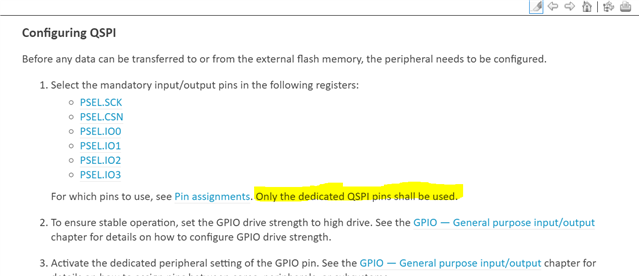Hello,
this topic came up during the Nordic Tech Tour some months ago, I was advised to create a ticket at Devzone to get some feedback from Nordic tech experts.
The nRF5340 has some dedicated pins for the QSPI interface (P0.13-P0.18), which also includes the Chip Select signal according to the product specification.
Now, there might be use cases where you want to use multiple QSPI devices at the same time, for instance the nRF7002 Wifi companion chip and a QSPI Flash memory that holds user data and can be updated/accessed via Wifi.
My question is: Can other pins be used for additional Chip Select signals than P0.13-P0.18 (which does not have a spare pin for an additional Chip Select)? Do I get reliable QSPI communication if I just use a random Chip Select pin in the QSPI's PSEL register? As Chip Select is not operated with high frequency, it shouldn't affect the QSPI communication. But there might be some waitstates before beginning the QSPI transfer necessary in the case that other Chip Select pins might come with a higher latency for a single level change... so I want to know if it is "safe" to use non-dedicated Chip Select pins for the QSPI interface.
In worst case, I think it should be possible to use QSPI with multiple Chip Select signals by manually setting the Chip Select signals and disableing it in PSEL. Can you confirm this will work?
But it would be more convenient if I could just change the PSEL setting before each QSPI operation and everything would work out of the box. So please let me know which approach is possible with the nRF5340 and what not.
Maybe you could also add a comment to the Product Specification about this topic.
Best regards,
Michael
PS: My ticket is related to this one

